
"Voted game most unlikely to have a demo disk in PC GAMER." - Author's description
Download on itch.io (Windows)




"Voted game most unlikely to have a demo disk in PC GAMER." - Author's description
Download on itch.io (Windows)



No California Republican has voted in favor of a state budget proposal in years, so it was a little startling when one did on Monday. He may have been the most startled of all, because he wasn't really paying attention, as he later conceded on Twitter.
In other words, while he was busy complaining about Assembly Bill 93 on Facebook, he accidentally voted in favor of it.
It makes no difference for at least a couple of reasons. First, the California Legislature has been firmly controlled by the Democrats for some time—the Assembly, for example, is currently split 52-28. Because the GOP has no hope of prevailing on a budget vote, its members might as well vote against any budget if only so they can later say they did. But this budget bill would still have passed, of course, whether it got 53 votes or only 52.
Second, because the floor vote is not actually the official vote—or, at least, because California allows lawmakers to go back and change the official record, as I would guess most legislatures do—Wilk's wayward vote officially never happened. There doesn't seem to be any "interim" vote total (although it might be in the daily file somewhere), so for example even though this vote summary is captioned "UNOFFICIAL BALLOT," Wilk's vote is right there in the "NOES" section along with those of his colleagues. It is more difficult to stuff things down the memory hole than it used to be, of course.
According to the report, Wilk changed his vote after the session ended, "receiving applause from fellow Republicans and boos from Democrats," all of whom were semi-pretending it mattered.
Mrs. Wilk is right, of course, that her husband can't "multitask," because no one can.
"The research is almost unanimous, which is very rare in social science, and it says that people who chronically multitask show an enormous range of deficits. They're basically terrible at all sorts of cognitive tasks, including multitasking." Clifford Nass (a Stanford psych professor) in "The Myth of Multitasking," NPR Science Friday (May 10, 2013); see "Mistrial Declared After Jurors Found Playing Sudoku," Lowering the Bar (June 10, 2008); see also Everyone Who Has Ever Texted While Driving, Everywhere (Anytime).
We often see 18-year-old Lisa around Harajuku because she works at the popular vintage boutique Pin Nap.
In addition to her purple partially braided hairstyle, Lisa’s look features a denim jacket and shorts from Pin Nap Harajuku with a resale top. Her sackpack and white sneakers are both Nike. She accessorized with an oversized earring, silver ring, black nails, fishnet stockings and sports socks.
Lisa enjoys shopping at Pin Nap and she’s a fan of Big Bang. Check out her Instagram and Twitter for regular updates.






Click on any photo to enlarge it.
You all are familiar with the Teddy Bear, designing after Theodore Roosevelt’s love of shooting animals. It was a big hit during his administration. You can imagine how toy owners would want to capitalize on this. You can imagine the troubles TR’s utterly uncharismatic successor William Howard Taft would provide in said capitalization.
But that doesn’t mean they didn’t try. And that leads us to Billy Possum:
That story starts, unsurprisingly, with Taft at the dinner table.
In January 1909, the president-elect was honored at a banquet in Atlanta. At Taft’s request, the main course was “possum and taters”—a toasty pile of sweet potatoes topped with an 18-pound whole cooked opossum. (Taft gobbled up the roasted marsupial so quickly that a nearby doctor advised him to slow down.) When Taft’s belly was stuffed, local boosters presented the president-to-be with a small plush opossum. The toy, they told Taft, was destined to be the next big thing—it was going to replace the teddy bear.
They dubbed it “Billy Possum.”
The gift pleased Taft—as did the dinner. The next day, he told reporters, “Well, I certainly like possum … I ate very heartily of it last night, and it did not disturb in the slightest my digestion or my sleep.” But what Taft saw as food, his supporters saw as money. The teddy bear boom had been profitable, and Taft’s supporters were confident the new toy could become the next fuzzy fad. They imagined America’s children tossing away their teddies, flocking to the closest storefront to get their hands on a plush opossum.
It failed miserably. But lord knows the toy companies tried:
The market flooded with Billy Possum postcards, pins, and posters. Marketers introduced Jimmie Possum—Billy’s running mate—named after Vice President James Sherman. Supporters could join a group called the “Possum Club.” Composer J. B. Cohen and lyricist G. A. Scofield even wrote a ragtime tune called “Possum: The Latest Craze,” whose last verse goes:
Ole Teddy Bar’s a dead one now
Sence Bill Possum’s come to town.
An’it taint no use to make excuse
Or raise a fuus an’frown.Jes get in touch wit’de President
Eat possum when you dine.
Den ask a Job of de Government
An’ you’ll cert’ly be in line.
In what could be an explosive decision, the California Labor Commission has found that a driver for Uber in San Francisco is an employee of the company. That’s from a ruling filed in state court on Tuesday and first reported by Reuters. It’s pretty damning. “Defendants hold themselves out as nothing more than a neutral technological platform, designed simply to enable drivers and passengers to transact the business of transportation,” the commission writes. “The reality, however, is that Defendants are involved in every aspect of the operation.”
Why so huge?
Just as importantly, drivers who are contractors, and not employees, also aren’t required to get benefits and other labor protections that employees are traditionally awarded. For Uber and all its peers in the so-called 1099 economy, this is another key thing that helps to keep costs low, rides cheap, and thin margins viable.
Determining whether workers should be classified as contractors or employees is rarely a simple matter. Uber points to its drivers’ abilities to set their own schedules as evidence that they operate independently and shouldn’t be considered traditional employees. Drivers, on the other hand, argue that Uber sets strict standards for how many rides they need to accept while on the road, and how they ought to interact with passengers—and reserves the right to deactivate their accounts (basically, the equivalent of firing) if they don’t comply. In California, where the issue of whether drivers for Uber and its main rival Lyft are employees is headed to trial, U.S. district judges have in two separate rulings declined to make a final decision. “The test the California courts have developed over the 20th Century for classifying workers isn’t very helpful in addressing this 21st Century problem,” one wrote.
So until now, the big, scary question—the one that could decimate Uber, and Lyft, and all the 1099 companies like them—has basically remained a hypothetical. Which is why it’s so important that the California Labor Commission has finally stepped in to say yes, this Uber driver is an employee, and she’s owed $4,000 in expenses. Imagine if Uber suddenly had to pay $4,000 back to all of its drivers in California, much less across the U.S. Even its $5.9 billion in funding would presumably wilt at the thought. It’s undeniable that Uber drivers becoming employees would be a huge blow to Uber’s business model. What we still don’t know is: How huge?
Effectively this entire industry is developed around a principle of labor exploitation. By forcing all of the costs of being an employee onto the worker, defining a worker as an independent contractor is part of the corporate toolkit to control workers’ lives without taking responsibility for them or having to pay into the social welfare net. Other tools include temp work (which today often means permanent work without benefits and multiple employees on the same Toyota shop floor in Kentucky working for different “employers.”), subcontracting, franchising, and outsourcing. Industries around the country have attempted to classify workers as independent contractors to avoid labor law and now we have seen new industries develop where this is the fundamental model. In all of these circumstances, the corporation at the top actually dictates terms of employment, often including hours and wages, or in the case of Uber, how many rides the drivers can accept. Moreover, Uber has full firing rights.
In other words, “disruption” actually means “finding new ways to exploit the working class.” Good for California for cracking down. Given the power of the Silicon Valley people in that state, we’ll have to see where this goes from here, but it’s a very promising decision.
Republicans know this too, which is why Grover Norquist thinks Uber is key for Republicans retaking the cities.

As a child, I was obsessed with video game maps. I would pore over them in old issues of Nintendo Power magazine, and even try to recreate the levels of my favorite games block by block on pieces of graph paper. I wasn't alone. In the early days of the Super Mario franchise, that's exactly how the folks at Nintendo were designing them.
"Back in the day, we had to create everything by hand," says Takashi Tezuka in a video promoting the upcoming level design game Super Mario Maker. "To design courses, we would actually draw them one at a time on to these sheets of graph paper. We'd then hand our drawings to the programmers, who would code them into a build."


If they wanted to make changes to the level, however, things got messy on the original document very quickly, so they started sketching out the changes on semi-transparent tracing paper placed over the maps.



"As the years went on and we made more and more sidescrolling games, we had to create a more advanced tool to design them with," says Tezuka. "This became the basis of Super Mario Maker."
The upcoming Wii game will give players the same sort of level-editing creative powers that once belonged only to designers like Tezuka, and allow them to design in the graphical styles of numerous 2D Mario games. It'll also include all-new bells and whistles like a "Luigi mushroom" that will give Mario the characteristics of his taller, thinner brother.
Super Mario Maker is slated for release on September 11, and you can watch the trailer below, or see some expert players get wrecked by some of its customized levels at the recent Nintendo World Championships.
[via Kotaku]
Death Waltz release re-scoring of The Strange Colour Of Your Body’s Tears
London’s 14th East End Film Festival will include a screening of Hélène Cattet and Bruno Forzani’s neo-giallo film The Strange Colour Of Your Body’s Tears with a new score curated by Ben Power (Fuck Buttons/Blanck Mass). On its initial release the film had no original music, drawing instead on existing giallo soundtracks. Featuring contributions from Blanck Mass, Helm, Moon Gangs, Konx-Om-Pax, Roll The Dice and C Spencer Yeh (aka Burning Star Core), Power’s new score will be released by Death Waltz on 24 July.
The screening takes place on 10 July at 7:30pm and will be followed by a DJ set from Blanck Mass and more. Tickets can be booked via the festival website.
Every graphic adventure I've worked on has at least one puzzle or interaction that seemed really simple when we designed it, but ended up becoming enormously complex and the source of countless bugs. This inevitably resulted in countless fixes, patches, and smiling sadistic playtesters eager to report yet another issue.
We call these Whack-a-Mole bugs. Fix one and another pops up right next to it. They usually happen when you don't think through all the possible side effects of your design choice, and from needlessly complicating what could be a simple interaction.
 In Zak McKracken and the Alien Mindbenders, the "WaM" puzzle involved getting on the bus in San Francisco. Sounds simple, right? You just give the bus driver your CashCard™ and he lets you on. But I wanted to make this interaction flexible... more like real life. What if there were two characters (Zak and Annie) waiting for the bus? What if one didn't have enough money on their CashCard™? Could one pay for the other? What if one was at the bus stop but didn't board the bus before it left? What if the bus driver went back to sleep after you already boarded the bus and paid? What if the bus just left with Zak and Annie walks up—should another bus be there, or should we wait a suitable period? Because of countless weird permutations, the image of our lead playtester evilly smiling at my office door is burned into my memory.
In Zak McKracken and the Alien Mindbenders, the "WaM" puzzle involved getting on the bus in San Francisco. Sounds simple, right? You just give the bus driver your CashCard™ and he lets you on. But I wanted to make this interaction flexible... more like real life. What if there were two characters (Zak and Annie) waiting for the bus? What if one didn't have enough money on their CashCard™? Could one pay for the other? What if one was at the bus stop but didn't board the bus before it left? What if the bus driver went back to sleep after you already boarded the bus and paid? What if the bus just left with Zak and Annie walks up—should another bus be there, or should we wait a suitable period? Because of countless weird permutations, the image of our lead playtester evilly smiling at my office door is burned into my memory.
 After I'd spent days, nah, weeks, fixing these WaM bugs, I wondered about the overall coding and debugging time investment vs. gameplay payoff ratio. Was I really making the game more fun or would my time have been better spent on a game interaction with a higher Funitivity Quotient™? For example, if the boarding-the-bus bit had been a cut-scene, it wouldn't have made much difference to the overall playability of the game. (So what if the driver was rude and left Annie standing at the bus stop?!) You could have just walked up to the bus and automatically ended up at the airport, CashCard™ appropriately debited.
After I'd spent days, nah, weeks, fixing these WaM bugs, I wondered about the overall coding and debugging time investment vs. gameplay payoff ratio. Was I really making the game more fun or would my time have been better spent on a game interaction with a higher Funitivity Quotient™? For example, if the boarding-the-bus bit had been a cut-scene, it wouldn't have made much difference to the overall playability of the game. (So what if the driver was rude and left Annie standing at the bus stop?!) You could have just walked up to the bus and automatically ended up at the airport, CashCard™ appropriately debited.
It's been over 25 years since Zak, but the bus puzzle still keeps me up at night. No, not really... it's the stewardess-bathroom-egg-in-microwave puzzle! Anyway, because I've got all these extra waking hours I am always on the lookout for similar interaction problems where we could put in way too much time for the payoff. In Thimbleweed Park, one potential candidate is... The Elevator.
 There's a single elevator in Thimbleweed Park's Edmond Hotel. You can board it, select your floor, and ride up or down, just like in a real elevator. What I haven't addressed yet are all the complexities. What if Agent Ray is riding the elevator and you switch to Agent Reyes who pushes the call button from a different floor? Must we make the elevator behave like a real one and stop at the floor to let the other character on? What if two characters both press the elevator button at about the same time? What happens if both characters board and press buttons for different floors? (That's what we expect on a real elevator, but do we need to implement this on our virtual one?)
There's a single elevator in Thimbleweed Park's Edmond Hotel. You can board it, select your floor, and ride up or down, just like in a real elevator. What I haven't addressed yet are all the complexities. What if Agent Ray is riding the elevator and you switch to Agent Reyes who pushes the call button from a different floor? Must we make the elevator behave like a real one and stop at the floor to let the other character on? What if two characters both press the elevator button at about the same time? What happens if both characters board and press buttons for different floors? (That's what we expect on a real elevator, but do we need to implement this on our virtual one?)
See how things can get real complicated real fast? But on the other extreme, if the implementation is too simple, it could frustrate the player who expects Thimbleweed Park Hotel's elevator to interact like real ones. "Hey! What's wrong with this game? Why can't I press every button and stop at each floor?! And where's the emergency STOP button?"
 For a first pass, I programmed the elevator so we can move around the hotel. I'm still looking for that balance between time invested in modeling reality and fun for the player.
For a first pass, I programmed the elevator so we can move around the hotel. I'm still looking for that balance between time invested in modeling reality and fun for the player.
Similar potential craziness involves what to do when you can see from one room into the next. For example, if Ray walks down the street and stands at the doorway to the bank, and then you switch to Reyes inside the bank. If Reyes opens the door to leave, should we see Ray standing there (on the other side of the door,) even though that's really a different room? Should we design all our rooms so you can never see through to another room? In our old adventure games we never worried about this. Probably won't now. Sometimes reality is just not worth programming.
- David
| archive - contact - sexy exciting merchandise - search - about | |||
 |
|||
| ← previous | June 15th, 2015 | next | |
|
June 15th, 2015: This comic would've been much better timed for Father's Day, or better yet... Grandfather's Day. Is that a thing? The vast global network of information we've built so that I might satisfy my every curiosity at a moment's notice says: yes! – Ryan | |||

"An ethical alternative to music streaming services." - Author's description
Purchase for £5 on itch.io (Windows, Mac)


Shebang Bash is a two-part event at Babycastles (137 West 14th Street, Floor 2, New York City) on Thursday, July 2.
The workshop (beginning at 6pm) provides an opportunity for anyone to begin developing computational poetry by modifying existing programs. Those without programming experience are particularly encouraged to attend. Workshop participants will develop, share, and discuss their work. Participants must register in advance and bring their own notebook computer running Linux, Mac OS, or Windows. (A tablet or phone will not suffice; computers are not available at the gallery.) Those who wish to can show and/or read from their work during the second part of Shebang Bash, although presenting during the reading isn’t a requirement.
The reading (beginning at 8pm) will feature work from Nick Montfort’s #! (Counterpath, 2014), modified versions of Montfort’s “Taroko Gorge,” and poems developed just previously at the workshop. Montfort will read from several pieces in #!, will screen concrete poems from the book, will discuss the project of this book and his computational poetry practice, and will answer questions.
#! (pronounced “shebang”) is a book of programs and poems, consisting of short programs in Python, Perl, and Ruby followed by examples of their output. While the book is published by a small press that specializes in poetry, part of its heritage can be traced to BASIC programming books and magazines from the 1970s and 1980s. Copies will be available for sale at Shebang Bash.
Tickets to the reading will also be available at the door on the day of the event. For workshop tickets or to get reading tickets in advance, see the Eventbrite page.
I guess I’d now give that greatest living jazz musician title to either Cecil Taylor or William Parker. Probably the latter.
….Also of course Sonny Rollins, who actually probably does take that title.
[SL]: The Coleman show I saw in 2008 was easily one of the 5 best musical experiences of my life. This a huge loss — he was a true giant of American art.
Clay Harper shows us a couple of excavators contentedly munching on the Casey Overpass.
Taylor SwiftO__________o
Here's one:
Over dinner, CEO [redacted] directed an unwelcomed "joke" to Ms. [redacted]: "Would you rather have your female genitalia on your hand so everyone could see it, or would you rather your husband have his male genitalia on his hand so everyone could see it?"
That's one of the as yet unproven allegations in this complaint (via Courthouse News Service), which charges the company with fostering a "hostile work environment." Here's another one:
Despite objections by Ms. [redacted], Mr. [redacted] continued, bringing up such things as references to his wife, "gimp monkeys" and "impotence."
Also, another thing not to say would be:
Mr. [redacted] and another Senior Executive, Corporate Controller [redacted], described how a giraffe and a goat could be placed to mate in cross-species sex, and the breeding [of] a giraffe and a goat [hybrid].
And then also do not say:
Mr. [redacted] described how his college roommates made molds of their penises and displayed them on the mantle in their apartment.
Finally, how many times must I remind people not to do this:
On another occasion, Mr. [redacted] told Ms. [redacted] not to dream of [redacted]'s Chief Financial Officer wearing a singlet wrestling his prom date while naked midgets are cheering for him on the sidelines using Siamese furry cats as pom poms! [sic]
This might or might not be a continuing series.
Taylor SwiftThis is GREAT: https://www.youtube.com/watch?t=47&v=t2oGrDVPEJI
Taylor Swift"Built upon little more than an eerie, pulsing synth pattern and Mithra's melancholy, sacred-sounding vocals, it encapsulates everything that is great about Vox Populi! in just 3 minutes: strong, yet understated melodic sense; haunted-sounding, otherworldly beauty; uncluttered simplicity; and something that sounds a lot like heavily processed (and vaguely menacing) recordings of some ducks."
elrondbaggins:tardis-mind-palace:the real question is why I was completely ready to accept that this person had a debilitating childhood fear of Danny Devitoruthyless:Who the fuck changed this from vampires to Danny devitowhen i was younger i had a really bad fear of danny devito when i was going to sleep so my older brother gave me a watch that he set to like 8 hours ahead so that it was always daytime on the watch when i was asleep and he told me it would confuse danny devito and he would think it was daytime and get scared of the sun and leave me aloneYour brother is the best
Taylor SwiftI have saved my gold for 900 days and 900 nights to buy the finest potions from this duo
Gothmura and Ayaca are two 19-year-old fashion students who caught our eye in Harajuku. You might remember their previous street snaps.
Gothmura – on the left with the top hat – is wearing a ruffle shirt from Atelier Boz with a Black Peace Now laced vest, lace-up Atelier Boz pants, and ankle boots. Accessories include his top hat, a cane, and a beautiful leather bag by Miho Matsuda. Gothmura’s favorite designers include Atelier Boz and Alice Auaa. He listens to the music of Nobuyuki Tsujii, Black Veil Brides, and the Japanese visual kei band Karasu (Crow). Find Gothmura on Instagram or Twitter for more info and pictures.
Ayaca – on the right with the bangs and dip dye hair – is wearing a black resale dress over a resale lace top, and Murua platform boots. Accessories include a silver crown ring and a red leather resale backpack. Ayaca’s favorite fashion brands/shops include Kujaku and Clique Tokyo. She likes punk music as well as [Alexandros] and My Chemical Romance. For more pictures and info, follow her on Instagram or Twitter.











Click on any photo to enlarge it.
Taylor SwiftThis
game
is
so
good
I grew up playing a lot of classic shooting games, like Doom, Quake, Half-Life and Counterstrike. But somewhere along the way I grew weary of the repetition, the point-and-kill gameplay and the hostile online cultures that surrounded them. Call of Duty, Modern Combat, Warface—all of them started to blend together into one forbidding, beige-gray murderscape.
Enter Splatoon: the Wizard of Oz moment where a shooting game finally burst into glorious technicolor, and suddenly everything looked different.
The premise is as simple as it is weird: You're a kid, but you're also a squid, sometimes known as an Inkling. You can play as a girl or a boy, but trust me—the girl looks way cooler. Instead of bullets, your weapon of choice is colored ink; while you can "splat" your foes and send them back to their home bases, your goal isn't actually killing people. Instead, you're trying to paint as much of the level as possible with your team's color, using a wide array of paint guns and projectiles. Of course, the opposing team is trying to do the exact same thing, and that's where things get messy and fun.
When you transform into a squid, the level opens up in a totally different way; you can surf across the level at high speeds anywhere that your team has spilled its particular shade of ink, turning your brushstrokes into a cephalopod fast lane that can shoot you up walls and off ramps. It's a game that feels like a cross between a paintball fight and a waterslide, and is exactly as fun as that sounds.
A retro '80s and '90s vibe reverberates through the game, evoking both the bright, slime-time fun of Double Dare and the bizarro cool of Toejam and Earl. Splatoon seems oddly determined to single-handedly resurrect the word "fresh" from the neon grave of the Nickelodeon era. Rather than just anachronistic jargon, "freshness" is an actual indicator of your level, and the stores where you buy your weapons (and your legitimately stylish clothing) won't hesitate to toss you on the street for not being "fresh enough."
In any other game, this sort of dad-hipness might doom it to condescension, but Splatoon's earnestness and absurdity takes it so far it almost comes back around to being cool again. It's kind of amazing how quickly you can buy into something when it aims so earnestly for wide-eyed silliness; it didn't take long before I found myself yelling things like, "I think I made it to the next level of freshness!" without a hint of irony.
After all, in a game where you buy sneakers from a potentially self-immolated shrimp tempura named Crusty Sean and everyone speaks in an Animal Crossing mumble, why shouldn't your squid kids call things fresh?

At their core, shooting games are about something very simple: making lines intersect with objects. This act takes on a different tenor when every line is a bullet, and every object is a human body. Given enough time, the idea of shooting games as entertainment—and particularly the militaristic and most popular ones—inevitably spirals towards the gravity of an uncomfortable question: should killing people really be fun?
The last shooter I truly loved was Goldeneye 007, which incidentally had a paintball mode. In retrospect, it was an oddly dissonant experience: the weapon you carried still looked like a machine gun, and the nameless enemy agents you mowed down still looked like they were being shot to death, but when your bullets went astray, they speckled the walls like candy-colored bloodspatter.
For the most part, shooting games have grappled with their moral weight either by embracing the thrill of mindless abandon or adopting an awkward self-awareness, attempting to wrap more "sophisticated" stories around the mechanic of killing sprees, and draping the unwieldy mannequin of mass murder with a more flattering (or 'meaningful') silhouette. These trappings tend to result in the narrative version of Goldeneye's paintball mode: a superficial gloss at best.
Although the last decade and a half has produced some novel takes on the genre like Half-Life and Bioshock, by and large the modern shooting game remains locked in a Live, Die, Repeat purgatory where heavily armed, square-jawed white men and indistinct armored figures circle each other in endless, contrived death spirals that always claim to be different, but are always the same.
Shooters make billions of dollars every year; they are very popular. And isn't that always the catch-22 of popular entertainment: the desire to claim that you are delivering something risky and wholly new, while delivering the safeness and sameness you know everyone already likes—the sequel with all the characters you love that will be like nothing you have ever seen before.
It's pretty much always a lie. But Splatoon is the truth.
There's a lack of viciousness in Splatoon that feels especially refreshing, a conscious effort not only to encourage fun, but to discourage animosity. It's a value reflected both in the look and feel of the game, and in its most basic interactions: success is ultimately measured in your color's total surface area, not "kills."
If you're playing online with strangers, you're automatically sorted into two groups of four on four, but after each match the players who continue are sorted again into completely new teams. It's kind of hard to develop a vendetta against anyone when the guy who was kicking your ass suddenly becomes your teammate. And when you do get "splatted," the message that pops on screen doesn't focus on the name of the person who killed you but rather weapon they used to wipe you out. Especially in the early going, my first reaction wasn't "screw you!" but "hey, I want one of those!"
For women interested in online gaming, the horrific abuse that often greets the mere sound of a female voice is its own separate gauntlet, but since Nintendo's Miiverse mercifully forbids voice chat, this is blissfully absent.
Instead, the primary way to interact with your fellow players is by drawing and sharing heavily moderated art and messages in communal spaces, which can range from Spongebob Squarepants and 50 Shades of Grey jokes to to surprisingly poignant messages in a bottle.

Despite all its hyperkinetic, free-for-all action, there's also something unexpectedly soothing about Splatoon, and the coloring-book pleasure you get from filling in its spaces with slick strokes of hot pink and blue and green. The Splat Roller is a special (if controversial) treat, cutting a blunt swath of paint across your path—and leveling anyone in your way like a steam roller.
Each time the opposing team painted their way across our side of the board, I found a quiet delight in following behind them, mopping up their colors with a fresh coat of my own. It felt like wiping dirty footprints off a clean floor. It's the same feeling provoked by those Buzzfeed lists of "oddly satisfying images," where objects combine, divide and unravel in smooth, symmetrical and color-coded ways.
There's a strange pleasure to arranging items in row, to filling a shape with a color, to making an object intersect with a line. There is something inside many of us that loves a perfectly bisected piece of fruit, a perfect headshot. Splatoon zeros in on the satisfaction common to them all: the zen thrill of the moment where order and completion emerges from chaos.
Initially, I focused far more on painting than I did on shooting; I didn't like shooters, after all. Maybe I could play more of a supportive role, I thought—you know, really focus on my art. My pacifism lasted exactly as long as it took me to round a certain corner while holding a semiautomatic paint dispenser, and mow down two of my opponents with quick, surgical strikes. As I saw their little squidly spirits rising from their bodies, I felt a very different sort of satisfaction coursing in my veins.
"I killed them!" I shouted, doing a brief but enthusiastic victory dance on the couch. "They died because of me!"

Like most people, I have a lot of competing or even opposing impulses and interests; there's clearly a part of me that enjoys the competitive side of shooters. It's just that those pleasures are typically buried inside a visually, narratively, aesthetically and personally hostile carapace, and I'm not usually interested in digging quite that deep to extract them.
Splatoon stripped that ugliness away, laid the best parts of shooting games bare, and covered them in a thick coat of strange, brilliant color. In a way, it reminds me a little of Left Behind, a companion piece to the zombie survival game The Last of Us. You spend most of the original game protecting a young girl named Ellie, but in this prequel tale you become her. She hasn't learned how to fight yet, so the skills you developed over the course of The Last of Us take on very different forms.
Before, you threw bricks in order to distract the undead; now, you and your friend walk around an empty, post-apocalyptic mall together and invent a game where you lob bricks at the windows of abandoned cars. Before, you learned how to stealthily sneak up behind your foes and shoot them in the head before they ate your face; now, you use the same skills—and button combinations—to have a water gun fight. It takes the mechanics of brutality, and transforms them into play.
That's how I felt, in Splatoon—like I was genuinely playing inside a shooter, in a way that I never had before.
Nintendo has taken a lot of hits over the last several years for its stubborn insistence on going its own way, especially when it comes to the Wii U platform. But with Splatoon at least, their iconoclasm has given us something truly special: a joyful, undeniably fun shooting game that upends the most alienating aspects of the genre while retaining its core pleasures—a game that looks and feels like a quintessential Nintendo experience, while still offering something original, exciting, and yes, totally fresh.
Taylor Swift"...a Newton easter egg is to write “Neat Bong”, select that text and hit the Assist button." WHO HAS A NEWTON??? WHAT HAPPENS???
I stopped at a surplus computer hardware store today and found a bin with a couple hundred of these:
So, if your Newton MessagePad 100 needs a battery holder, I know where you can go (RE-PC in Tukwila, WA). I have no idea how these things wound up there.
Gaston Bastiens was the General Manager of Newton when I was there. He was not well liked, and he kept making crazy decisions. For instance, he decided it would be good idea to charge Newton developers a percentage of their profits (unheard of at the time, and lunacy for a struggling platform). And: When it was clear that the Newton wasn’t selling all that well, and unwanted Newts were stacking up in warehouses, Gaston had Apple buy parts to make another 80,000 units. I won’t even get started about the sea of T-shirts we were swimming in (there’s a big difference between “Buy $5000 more promotional shirts” and “Buy 5,000 more shirts”).
There were a lot of Newtons sitting in warehouses.
Also, many Newton Fax modems. Many, many of them. God only knows how many he ordered. There could well have been more Newton Fax modems than there were Newtons to plug them into.
One of our developer support folks (Bob E) found out that it was possible to order a palette of surplus Apple products delivered to your office. Hey, the stuff had no hope of being sold, so if someone had a use for it . . . Bob ordered a big palette of Fax modems, and when he shipped stuff off to developers (hardware, manuals, etc.) he would pour in some Fax modems as packing material.
—-
We had a dev who liked to do anagrams. He maintained (somewhat tongue in cheek) that anagrams uncovered the true nature of things.
For myself, for instance: Dandy Loner
For Gaston: Neat Bong Assist (which is one of the reasons that a Newton easter egg is to write “Neat Bong”, select that text and hit the Assist button).
For one of our whip-cracking dev managers, a two parter: “Donate us a gun” (because) “Us at a dungeon“. The year we spent shipping Newton was a hard, hard year . . .
Taylor SwiftWhoa, what? Has anyone played the analog version?

They’re creepy and they’re kooky. [Image by Serendip01]
That said, the game should work just fine digitally. Each player controls a family that would make Gomez and Morticia proud, and the goal is to make them as miserable as possible before you shuffle off their mortal coils. Of course, your opponents are trying to do everything in their power to brighten your family’s day, and you’re doing likewise right back at them.
Yesterday, developer Sky Ship Studios announced that they will be starting a Kickstarter campaign later this year to bring Gloom to PC, Mac, and Linux. If the Kickstarter goes well, they will be looking at other platforms as well. Unfortunately, the Kickstarter isn’t even slated to begin until autumn of this year which basically makes me feel like I’m wasting everyone’s time. Damn.
Check out the teaser trailer after the break. Yes, it’s a teaser for a Kickstarter that’s at least 4-5 months away. What’s happening to me?

Author of fan site completes Deep Distance: The Musical Life Of Manuel Göttsching
A biography of German guitarist Manuel Göttsching has been published by Waveform. Deep Distance: The Musical Life of Manuel Göttsching is described by author Christian Wheeldon, who runs a blog dedicated to the artist’s career, as a labour of love and covers Göttsching’s work with Ash Ra Tempel, The Cosmic Jokers and Ashra as well as his solo career including the influential 1984 proto-techno album E2-E4.
The book features exclusive contributions from Harald Grosskopf, Lutz Ulbrich, Steve Baltes, Joaquin Joe Claussell and Steve Hillage along with photographs and reminiscences from fans.
More info on ordering the book, which is available now, online here.
Chiaki’s 1970s-inspired boho outfit caught our eye on the street in Harajuku. We found out she works in apparel.
Chiaki’s velvet jacket and floral shirt are both vintage, worn with flare jeans and a fringe bag from Grace Continental. Her heeled sandals and jewelry are all vintage as well.
We asked Chiaki where she shops, and she told us she likes the Japanese brands k3, G.V.G.V, Sacai and the Dover Street Market (by Comme Des Garcons) in Ginza. She also mentioned that she’s a fan of Arashi.







Click on any photo to enlarge it.
Taylor SwiftWOULD YOU LIKE TOO MUCH INFORMATION ABOUT THE VARIOUS PORTS OF DONKEY KONG???????? ALSO: DID YOU KNOW THERE WAS A CONSOLE CALLED THE "BeLogic Uzebox"??????
Important Introductory note
As well as the very simple to use Console based systems the new MAME also emulates a number of home computers.
Before you start there is one very, very important thing to keep in mind when running a computer in MAME, the default state of emulation is to give the entire keyboard on the system to the emulated machine, meaning that none of the usual MAME keypresses will activate MAME functions, this even means that in this state ESC no longer exits MAME, F3 doesn’t reset the system, P won’t pause/unpause etc.
By default there is one key assigned to toggle this mode on and off and that key is SCRLOCK (Scroll Lock) However some laptops and other modern keyboards (including my wireless Logitech) don’t have this key, so you’ll need to assign something else.
If you’re in that situation then (assuming you have MAME already setup, including ROM paths etc.) you should launch MAME with no parameters and use the internal menu to do the following:
Scroll down to “Configure General Inputs” select “User Interface” select “UI Toggle” (it’s about 70% down the list) and assign a new key to it, one that is out the way and unlikely to be used by the emulated systems, personally I picked ‘END’
I will refer to this key as ‘UI TOGGLE’ for the rest of this document, please be aware that if the UI is in ‘active’ state and you press ESC then you WILL exit the emulation so it’s important to remember to toggle it back off after each time you need to use the UI.
King of Kong – Arcades
In the previous part of the article I looked at how the integration of MESS made it easier to explore the different platforms to which a game was officially ported, this time I’m going to look a bit at how you can see the influence of a game, including both official and unofficial ports.
Even with just the Arcade side of things Donkey Kong is a game with an undeniably huge influence. In MAME, for a long time, there have been a number of takes on Donkey Kong, the arcade original looked like this:
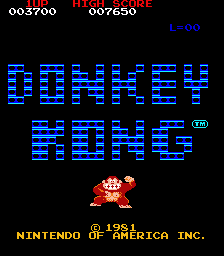
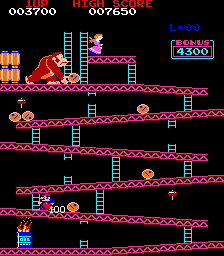
Even in the arcades there were a number of games that ripped off Donkey Kong. Crazy Kong is probably the best known variant of Donkey Kong and has a fair bit of history, and mystery behind it. While very similar in appearance it’s actually a very different piece of code to the original game. The Brazilian ‘Kong’ falls into the same category, it uses the Donkey Kong graphics, but the codebase is entirely different, resulting in a very stiff game with some redesigned levels; don’t be fooled by how similar it looks, there’s not a shred of the original Donkey Kong code in it!
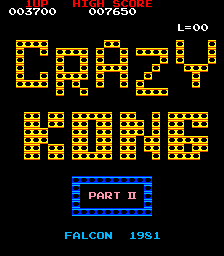
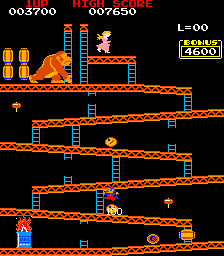


The influence extended beyond games that were basically just creative bootlegs of Donkey Kong too, the CVS system game ‘Logger’ for example directly took the Donkey Kong concept but gave it a woodcutter theme.
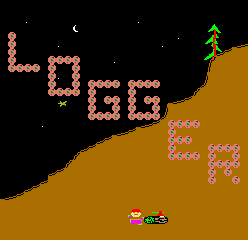
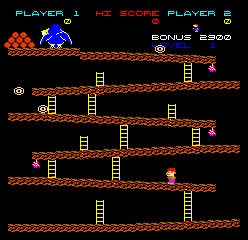
Even years later the game, and it’s sequels ended up being copied, one example is the ‘Tong Boy’ game within YunSung’s ‘New Multi Game’
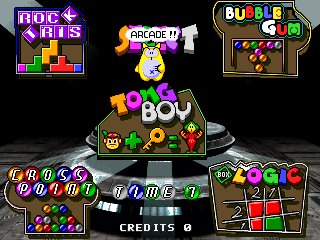
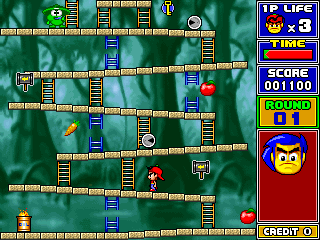
Let’s not also forget the unofficial sequel ‘Jump Man Returns’ which was made much more recently (2006) and plays out the idea of a sequel running on a modified version of the original game engine using the original hardware; quite a few PCBs actually ended up being converted to run it! Even more recently there were mods like the ‘Pauline edition’ where you play as the Heroine instead of Mario, although that one hasn’t yet made it to MAME (I’m hoping with the addition of the MESS stuff, and the more open / relaxed attitude towards after market developments it will)
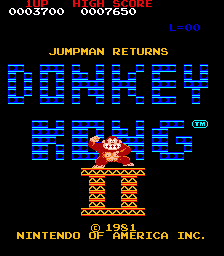
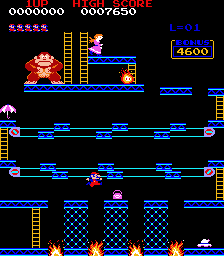
Beyond that there were numerous games that were clearly influenced by the game mechanics of Donkey Kong without actually being the exact same idea as Donkey Kong, there’s little point in me covering all of them, but needless to say it was a very influential game.
King of Kong – At Home
So that’s all things that were available in MAME already, so you’re probably asking ‘where does the newly added MESS component come in?’
Donkey Kong is a much earlier game than the previous covered Raiden, so the systems it was ported to were quite different, this was the 80s when home computers were commonplace.
The first port of Donkey Kong I’m going to look at is one of the most recent additions to the emulator, added in 0.161 it’s the Coleco Handheld which looked something like this
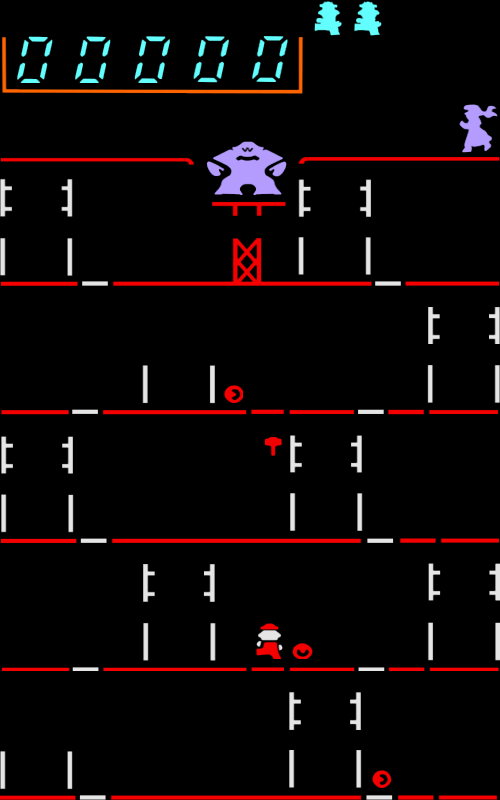

A little background information is possible required here. This was 1982. While today you have machines in your pocket that are often more powerful than the PC sitting on your desk, in 1982 we didn’t, even the original GameBoy was not released until 1989, and the only real handhelds with a video display to speak of were things like the Microvision with a 16×16 pixel display.
In order to make something with reasonable art a different approach was taken, instead of trying to make up a screen of pixels VFD based displays were used, this allowed the manufacturers to use actual art to make up the game graphics by turning on / off various playfield elements. You can see one of the actual units here . Obviously this technique means animation is non-existent and what could be done with the games was strictly limited, but the Donkey Kong handheld made a brave attempt at simulating both the barrel and rivet levels and has been quite fondly remembered.
I’ve uploaded a YouTube video of this below to better demonstrate it. To run this in MAME you use ‘mame cdkong’ be sure to have the ARTWORK FILE in your artwork folder too because it’s not really playable otherwise.
If you didn’t read the important note at the top of the article now is a good time to read it because we’re going to look at some of the home computer versions of Donkey Kong, there were many of them, I can’t possibly cover them all, but to help people understand the functionality it’s worth looking at a couple.
One of the most critically acclaimed ports of Donkey Kong was the one to the Amstrad CPC, and I’m not surprised, for a system that received, for the most part, shoddy reworkings of Spectrum ports that were unflappably slow this is an absolute gem.
Now, for some reason running the cassette version of the game in the base Amstrad CPC464 driver results in raster timing glitches, I’m not sure why, it just does, I guess it might be because the CPC has the disk rom hooked up by default when really it should only be available if you plug the expansion in, but then I’ve noticed it works fine on some of the other models with a disk drive.
Either way, there is an Amstrad clone, the KC Compact, and we’ll be using that for our first example.
Launch MAME with ‘mame kccomp -cass1 dkong” this will launch MAME with the KC Compact drive running, and the Donkey Kong cassette (from the Software List) inserted into the cassette deck. Without loading the game however it will just sit there.
To get us moving type
run”
and press enter, this will prompt you press PLAY then any key. The order you do this doesn’t matter here, so hit a key.
In order to start the tape playing you must enable the MAME interface keys, this is where the text at the top is important. Hit ‘UI Toggle’ (SCRLOCK by default) to enable the MAME keys.
Press F2, this is the keyboard shortcut to start a tape. A timer (3 minutes 36 seconds) appears in the top corner and the game begins to load. Hit the ‘UI Toggle’ key once more to disable the MAME keys again and hand the keyboard back over to the emulated system.
Wait. Eventually the game will load.

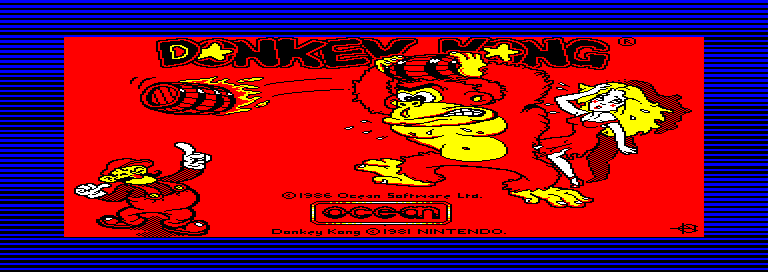
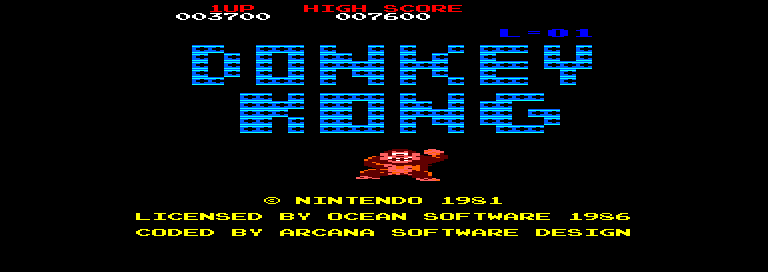
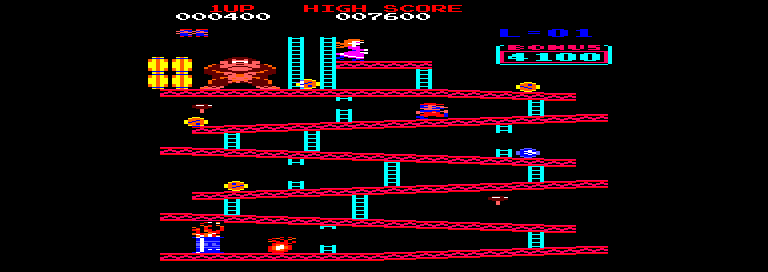
So far everything that has been covered in this articles has been loaded from the Software Lists. For ROM based games that is absolutely the correct way to go about things as the Software Lists often contain information about what was inside the cartridges, so some features like backup RAM might not end up being emulated properly if the Software Lists aren’t used, however for software that was on Cassette, Disk, or even CD Rom it is useful to know that unlisted software can also be loaded.
For the next example I’m going to look at one of the other 8-bit systems, the Sinclair ZX Spectrum.
Donkey Kong isn’t in the ZX Spectrum Software List (yet) so head over to the World of Spectrum and grab a loose copy. DonkeyKong.tzx.zip should do the trick, unzip it into your MAME folder so you have DonkeyKong.tzx sitting in the same location as your MAME.exe.
Launch MAME with ‘mame spectrum -cass1 “Donkey Kong.tzx”
this causes MAME to launch with the loose cassette image of Donkey Kong mounted in the cassette deck.
Now unlike the Amstrad, the Spectrum can be a bit of a pain when trying to load something because the build in BASIC uses a Macro system, meaning instead of typing words you must press keys that correspond to keywords. Luckily for loading a game you only have to know how to enter the command LOAD “”, which is ‘J’ (for load) then ‘Shift+P’ twice, for the “” part. After typing that, hit enter. The later Spectrum models have other easier ways of loading games, but not all software is compatible.
The procedure to start the tape is exactly the same as the CPC, hit the ‘UI Toggle’ (SCRLOCK), hit F2, tape starts playing, hit ‘UI Toggle’ again.

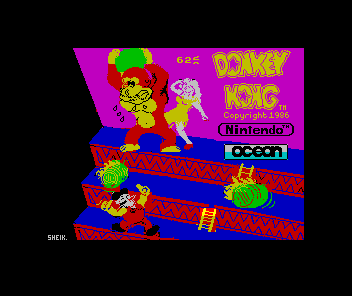
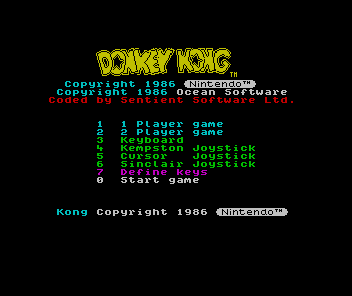
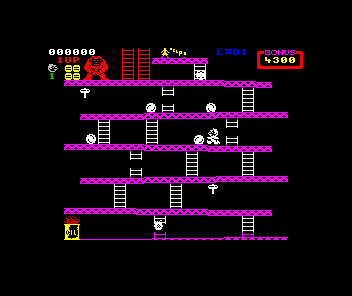
Not the best version of Donkey Kong, you can tell it’s meant to be Donkey Kong from the basic level structure but the graphics are dull and flickery and the controls / movement doesn’t really feel correct either.
With some of the systems now supported you’ll need to configure slots before launching the driver (unfortunately MAME still doesn’t support changing many of these at runtime which causes a problem with some games) To play the Commodore 64 (c64) version of Donkey Kong for example you’ll have to tell MAME that you want a C64 joystick inserted into one of the control ports. The launch syntax to do this is
“mame64 c64 -cart1 dkong -joy1 joy”
The Donkey Kong game in question is loaded from a cartridge, so the actual loading part is easy (loading a C64 game from Tape / Disk requires more effort) but without the -joy1 joy part, telling MAME that you want a joystick inserted into the first Joystick port it is impossible to control. With that added the game boots, can be started, and plays a reasonably good game of Donkey Kong.
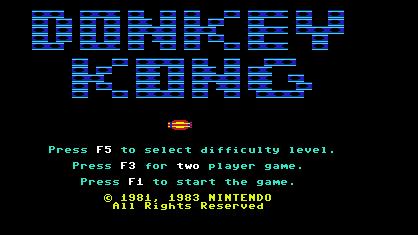
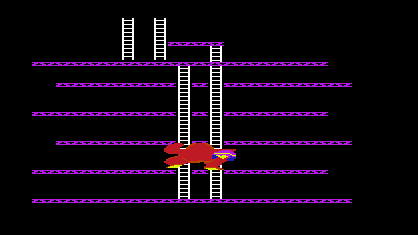
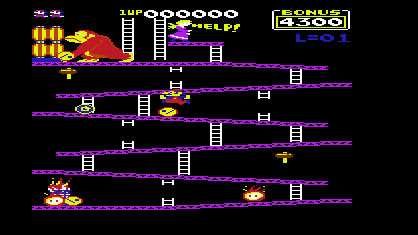
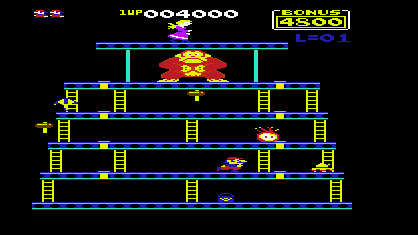
One issue that was touched upon with the mention of the Spectrum is how some systems can be rather difficult to operate simply because the original keyboard layouts were so different to PC layout we have today. While the Macro based inputs of the Spectrum couldn’t really be made any easier there are cases where MAME can assist a little, by attempting to remap keypresses transparently. The option to enable this is ‘-natural’
A good example of where this is useful is the MSX. By default the ” symbol is very difficult to find when running the MSX driver (in all honesty I don’t know where it maps) but if using the ‘-natural’ option it maps to the same place it does on a PC keyboard, Shift + 2.
Let’s launch the MSX driver with that option for an example. MAME doesn’t have a generic MSX driver as the MSX was just a rough specification for a machine rather than an actual machine. One machine based on that specification is the Canon V-20E (canonv20). The following commandline is used to launch “mame canonv20 -cass1 dkong -natural”
This starts up the MSX driver with the Donkey Kong cassette in the cassette desk.
To start the tape loading you must type
RUN”CAS:”
In the case of the MSX driver the tape then automatically plays.
For the game in this driver I’ve found that once the game has loaded you must select ‘4’ (Joystick) in order for the controls to work well, I’m not sure if this is a conflict with the ‘-natural’ option or something else.
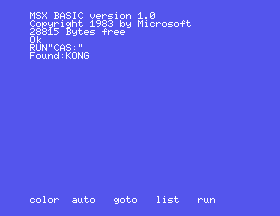
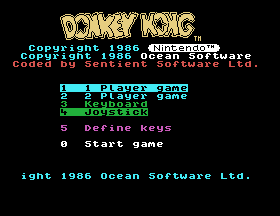
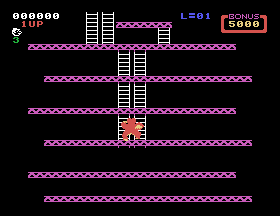
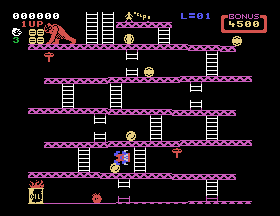
If you’re feeling lazy and pick an MSX model with a floppy drive then there’s actually a version of Donkey Kong available on Floppy Disk too.
The Expert DDPlus (Brazil) is one such MSX model, so using the launch syntax “mame expertdp -flop1 dkong” will load the floppy version from the Software List, exact same game tho.
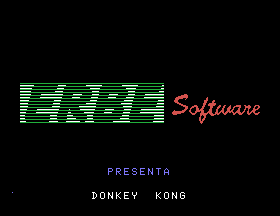
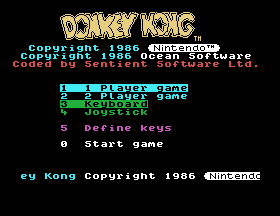
One thing I mentioned is influence, and an influential game leads to people still giving it care and attention many years later. Back in 2007 ‘Sock Master’ decided to do a port of the Arcade version of Donkey Kong to the CoCo 3 computer, with the goal of creating something as close to the arcade experience as possible.
In the end he succeeded in creating this port, although admitted that it performed better on a modified machine, one with the CPU upgraded. MESS was generally open to supporting unofficial modified hardware configurations (as long as they actually existed) so has a machine with precisely the recommended upgrades available by default. MESS was also open to some ‘homebrew’ software being documented, so this port made it’s way into the Software Lists.
To launch we use the simple syntax
“mame coco3h dkong”
Before going anywhere else it’s wise to hit the ‘UI Toggle’ key (SCRLOCK) bring up the TAB menu, scroll down to Analog Controls, and adjust the AD stick X and Y Digital Speeds and Auto Center speeds up to 50, why? because the system used Analog Joysticks, and the default mapping of ’10’ for the speeds makes the game very sticky. With the settings adjusted close the TAB menu (press TAB again) and hit the ‘UI Toggle’ key once again to give the system full keyboard access.
The game is on a floppy disk, to see the content of the floppy disk type DIR and press return. You can see see several files listed, the one with the .BAS extension (BASIC) is the game loader and the one we’re interested in, it’s called DONKEY.BAS. To run it just type
RUN “DONKEY”
and hit enter
once the game has loaded you’ll want to hit ‘P’ to change the Palette Type to CMP (Composite) or the colours will be ugly ingame. By default the controls map to the numpad, NUMPAD0 is credit/start, and the 8/4/6/2 directions move your character.
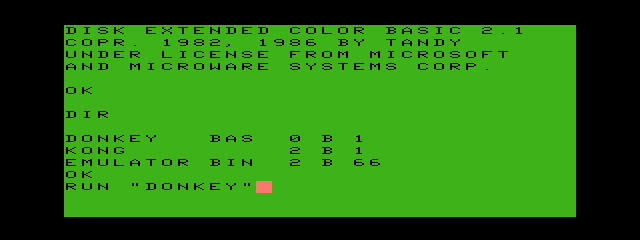
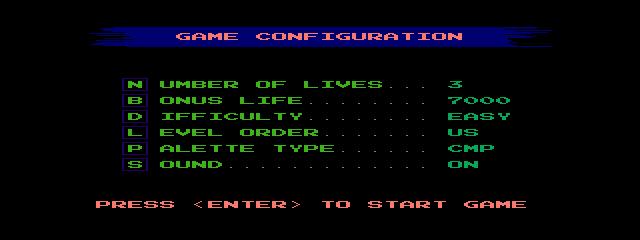
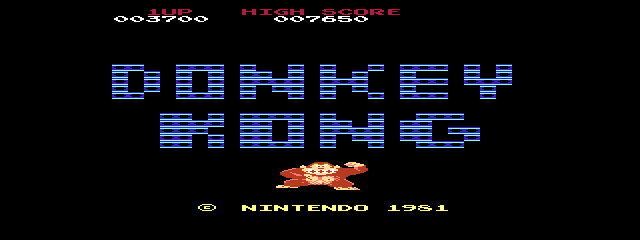
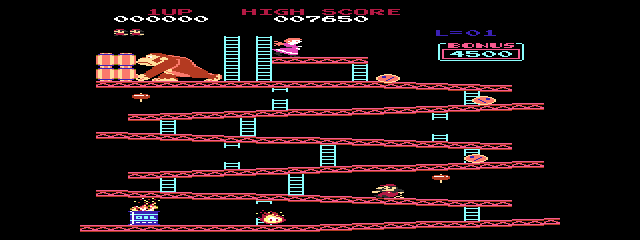
Some ports are really easy to get going, the Apple II port for example
“mame apple2p dkong”
With that, the game auto loads and can be played using the Numpad, not a great port, but still recognizable as Donkey Kong.
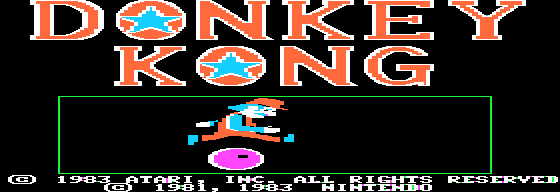
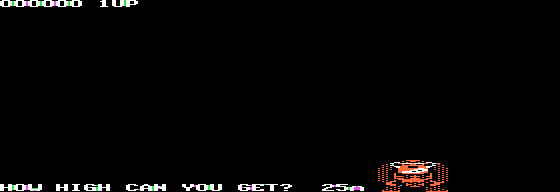
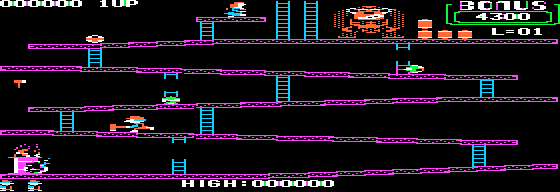
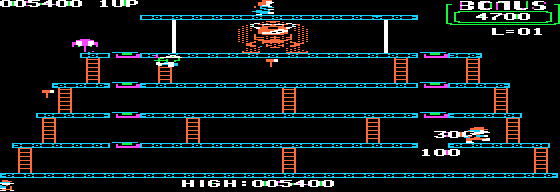
So far all the versions that need to be loaded via BASIC have been fairly straight forward, and have auto-ran after the initial load sequence. That isn’t always the case however, some need a little more attention, and a little more knowledge of exactly what’s on the tape you’re trying to run. Another thing that you get with certain systems is the ability to configure different RAM sizes as many of these computers came in different models with different amounts of RAM depending on how much you were willing to pay, or modify your machine.
One example that ends up incorporating both of these elements is the Colour Genie EG2000. There was an unofficial port of Donkey Kong to the machine known as “Colour Kong” It was available in 2 versions, a 16K version and a 32K version, we’re going to look at the 32K version.
The launch syntax we will be using is “mame cgenie -cass1 colkong32 -ramsize 32K” The -ramsize 32K option configures the machine as a 32K machine, it’s 16 by default, the valid options here are defined in the driver.
The built in BASIC for the machine is incredibly unintuitive. The first thing I’d recommend is hitting the ‘UI Toggle’ key (SCRLOCK) to enable the MAME controls, we’ll need them in a bit to start the tape.
Upon booting you get a MEM SIZE prompt from the machine, just hit enter, at that point it will say COLOUR BASIC and READY.
The first command you need to enter into the emulated machine is
SYSTEM
entering this, and pressing return gives you a *? prompt
This prompt is expecting you to enter a filename, to operate this system it appears you actually have to know the name of the file on the cassette, which is inconvenient to say the least. In this instance the filename is KONG32, so type KONG32 and hit return.
The system won’t prompt you to press play on the tape, but that’s exactly what it wants you to do right now, so hit F2 to start playing the tape. It takes about a minute and a half to load the game, during that time you’ll see some * symbols in the corner. After loading it returns you to the *? prompt
Again at this point it isn’t obvious what you must do, the game doesn’t auto-start (some games on the system do, but this isn’t one of them) to boot the game you must type a / symbol and press enter.
‘S’ starts the game, arrow keys move, Z is jump. It’s an unofficial port to an obscure system, and the barrel level is really tricky, but it does look like all the levels are implemented!
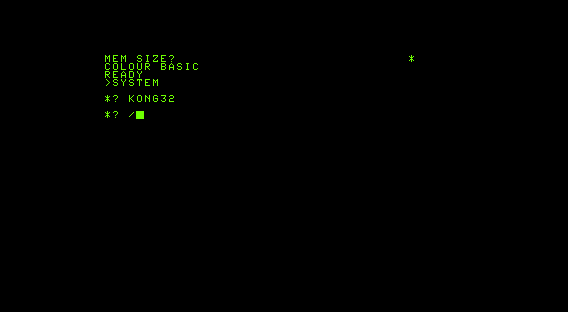
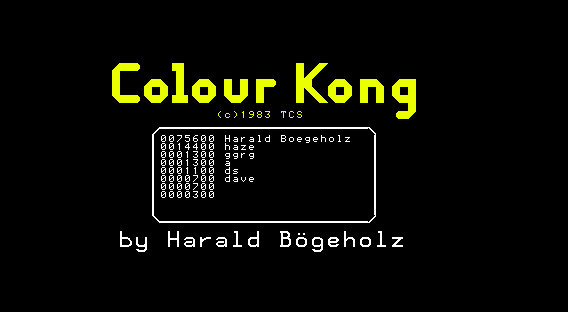
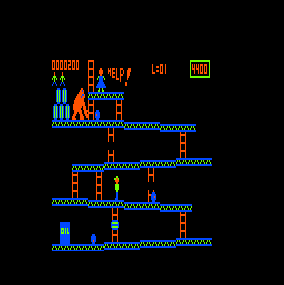
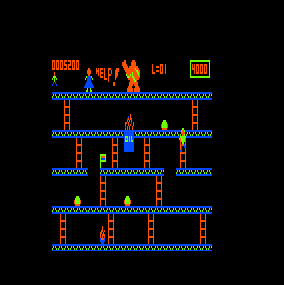
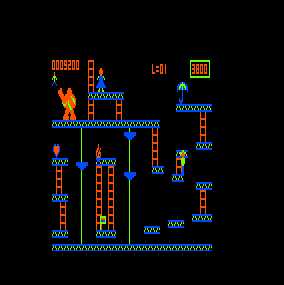
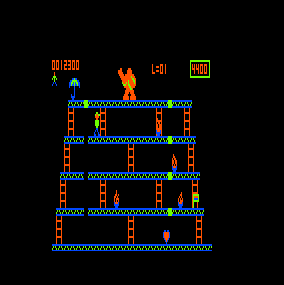
Another unofficial one I’ve since been made aware of in the comments below is the BBC Micro game ‘Killer Gorilla’ The BBC was another popular UK system, so it doesn’t surprise me to see somebody wrote a DK clone for it.
Launch the emulation with “mame bbcb -cass killergo”
I don’t recommending using the -natural option here because it does interfere with the keyboard controls of the game, so when typing the following commands into the emulation you’ll have to be careful because the keymapping isn’t entirely obvious.
To load the game you must type
*TAPE
CHAIN””
pressing return after each line. The tape will auto play and the game will load.
As I mentioned the key mapping isn’t obvious but on my keyboard the * symbol maps to the @ key, just up and left from the right shift key, this is also one of the game controls (climb up ladder)
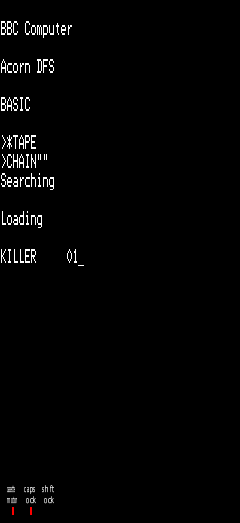
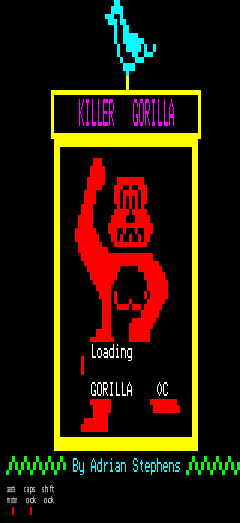
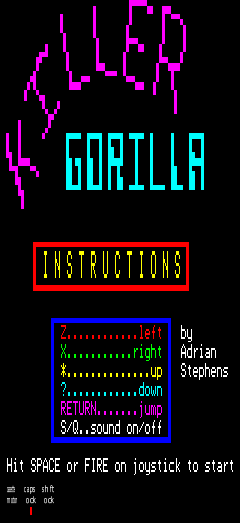
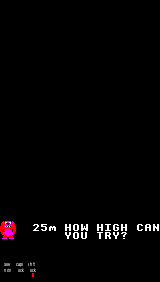
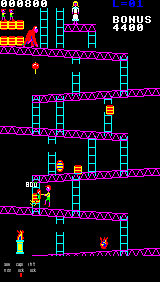
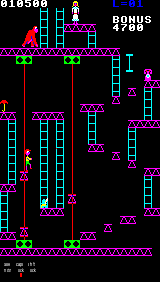
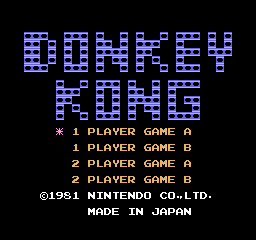
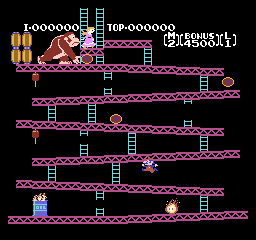
That’s an easy one out of the way, now let’s look at something a bit more complex again.
For some systems you have to attach additional hardware before slots become available. One such system is the Famicom, aka the Japanese version of the NES. The Famicom had a ‘Disk System’ addon which allowed for games to be distributed on Floppy Disk. To use the Disk System add-on, and thus play games on Floppy you had to first plug it into your main system. In MAME you have to do the same.
There are two ways of doing things from here, option 1 is that we launch the Famicom with
“mame famicom -cart1 disksys”
this boots to the disk system bios.
from there you can press TAB to bring up the MAME tab menu, scroll down to ‘File Manager’, select it, scroll down to ‘floppydisk (flop)’, select it, scroll up to ‘[software list]’ select it, then ‘Nintendo Famicom Disk Images’, select that, then just type dkong to scroll the list to Donkey Kong and hit return. Assuming you have the ROMs available and where MAME can find them that will work. While for the purpose of this example I’m just loading Donkey Kong, which is identical to the NES version, there are a number of unique titles for the Disk System too.
The other way to do the same thing (without having to navigate all the menus) is to simply launch with
“mame famicom -cart1 disksys -flop1 dkong”
however navigating the menus is good practice for some more complex cases you might encounter later, where you have to change disks at runtime.
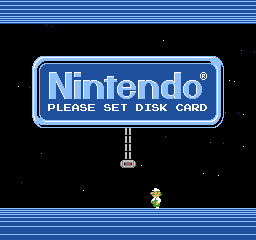

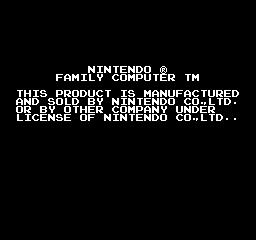
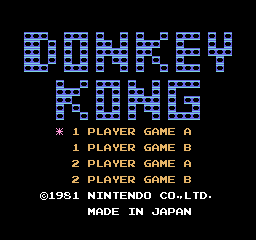
The majority of the rest of the Donkey Kong versions I managed to launch were easy cases, there are 3 of them for Atari Systems
The Atari 2600 had a very basic looking version of the game, with minimal presentation
“mame a2600 dkong”
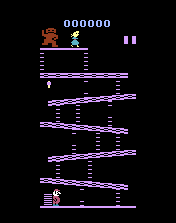
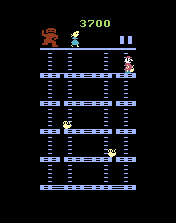
There was an Atari 800 version..
“mame a800 dkong”
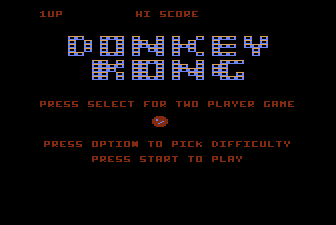
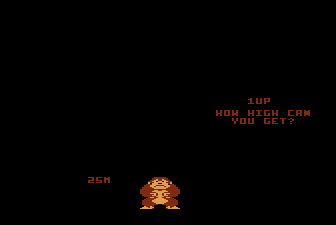
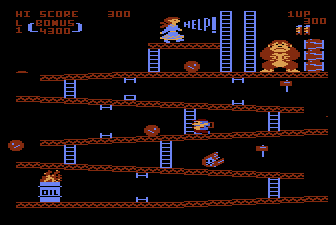
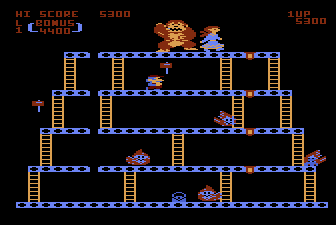
and an Atari 7800 version
“mame a7800 dkong”
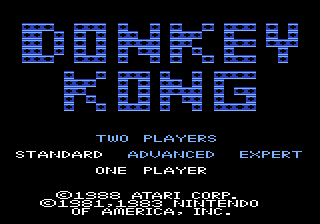
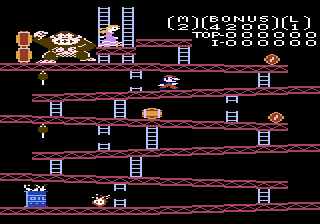
The interesting thing with the Atari 7800 version is that back in 2012 a new version was released to make use of the XM expansion card for the A7800, this expansion card added High Score Save support as well as additional sound chips. The original A7800 version of Donkey Kong has rather awful sound, so ‘TEP392’ decided to reprogram the game, improving it in significant ways. He released demo versions of this to the public to show off the improvements. The Demo version is softlisted, and our emulation does support the XM unit, unfortunately support seems to have broken at some point causing the Pokey to output static instead of the new music meaning I can’t really add that one to the ‘Things to try’ list for now.
****edit****
It would appear that the Software Listed version of the XM Enhanced Donkey Kong does NOT work, however the one that is listed as MESS compatible (dkxm_demo_v12_ntsc.a78) does – for some reason none of the files on that page are recognized, I guess they’ve been updated since it was originally added to the list. The version that is listed as for the real hardware works the same as the one in MAME, ie the Pokey doesn’t work, according to etabeta it did work at one point(?) but I don’t know.
Either way, with that loose file you can launch the enhanced version.
“mame a7800 -cart1 xm -cart2 dkxm_demo_v12_ntsc.a78”
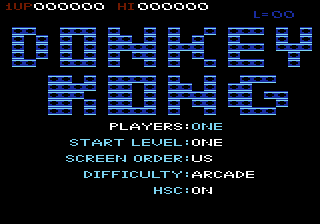
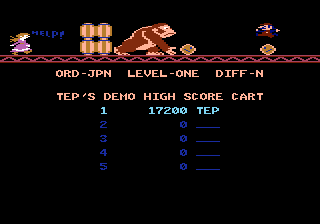
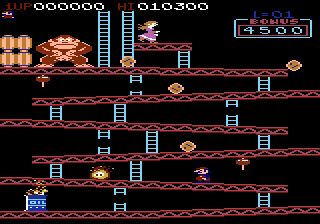
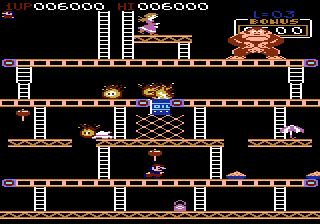
The Gameboy got a port of Donkey Kong too, however it’s not really faithful to the original game logic, you can do some back-flip type jump instead of using the ladders at times!
“mame gbcolor dkong”
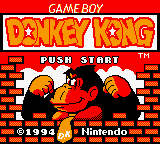
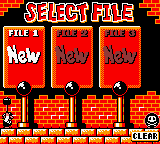
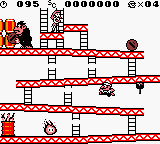
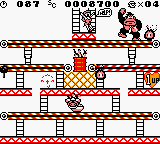
The Gameboy version was also special in another way, it was one of a handful of Gameboy games to have ‘Super Gameboy’ support. The Super Gameboy was an underutilized expansion device for the SNES which allowed Gameboy games to be played on the big screen with extra content (typically more colours, and a bezel) Most SNES add-ons are supported in MAME via the slot device system, however the Super Gameboy hasn’t been fully converted yet and is treated as a standalone system. For the purpose of running Donkey Kong this is good enough.
“mame supergb dkong”
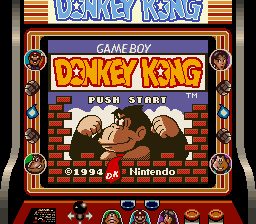
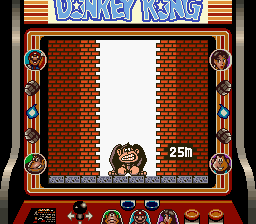
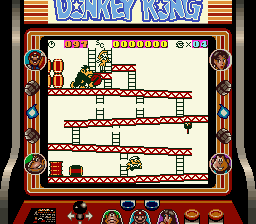
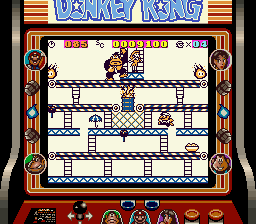
The Intellivison got a basic, slow and ugly port of the game, remember to use the numpad to select difficulty etc. or it looks broken.
“mame intv dkong”
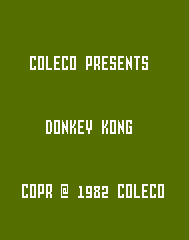
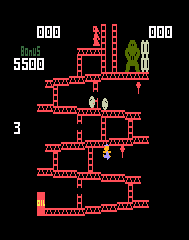
The Colecovision port plays well, but has minimal presentation
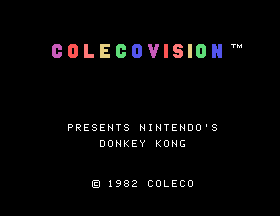

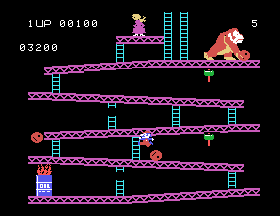
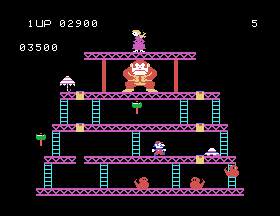
There was also a TI99-4a port
“mame ti99_4a donkeykg” (really this should be renamed to dkong to be consistent with the rest)
This one also plays a good game.
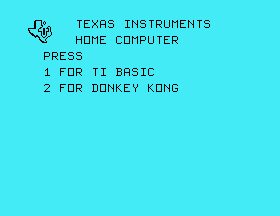
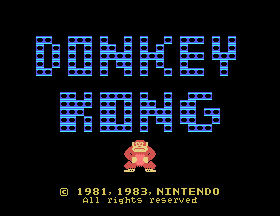
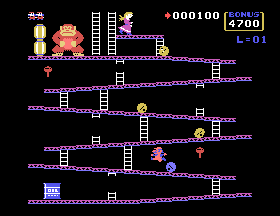
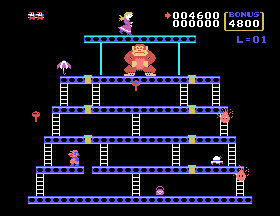
Venturing well into obscure territory is a port that was done for the BeLogic Uzebox. The Uzebox driver is marked as NOT Working in MAME, and lacks sound, but the actual gameplay of the Donkey Kong port runs fine, it’s not a great port, and the emulation does struggle to maintain 100% even on my 4Ghz i7, but it’s an interesting one because it shows how we’re interested in emulating these ‘Open Source’ games consoles and the homebrew software developed for them.
“mame uzebox dkong”
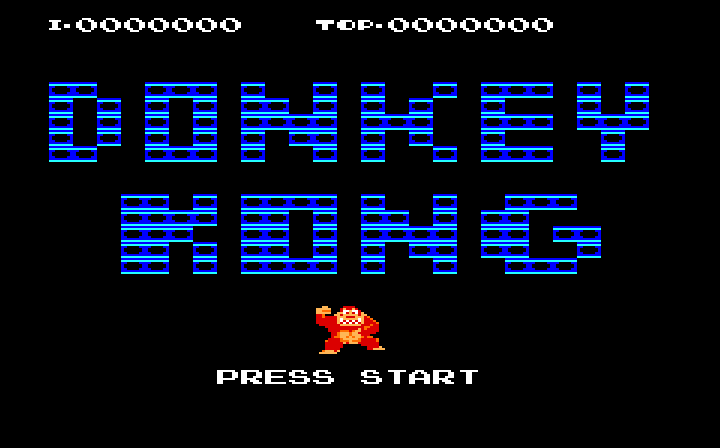
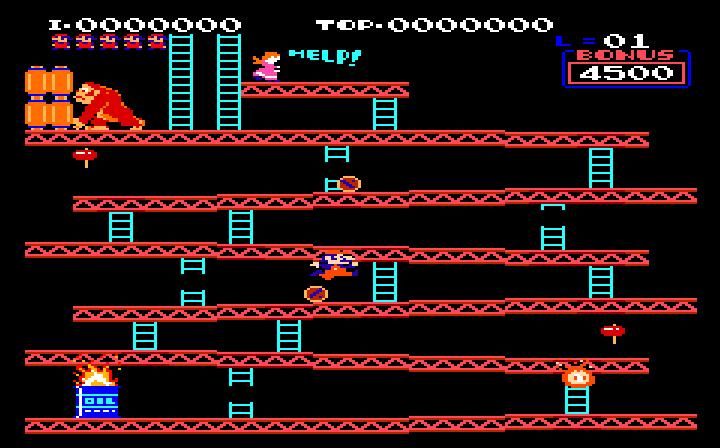
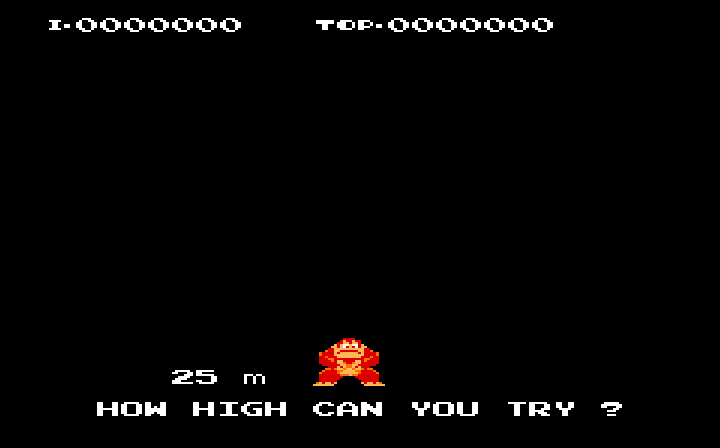
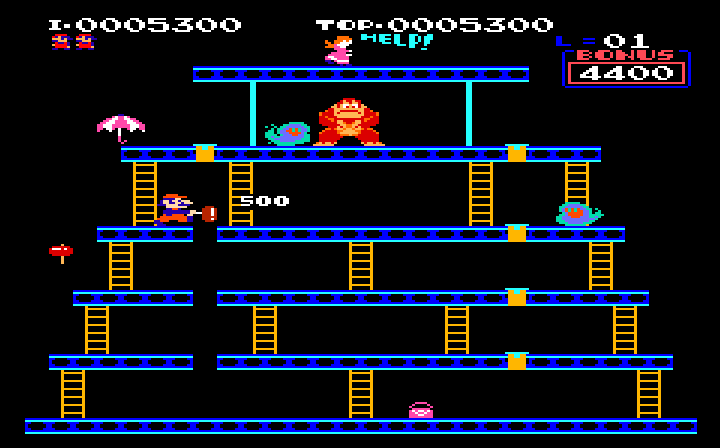
Not All Working
That concludes all the versions of Donkey Kong I could get working, there were a couple of others I couldn’t, the Vic20 version for example hangs on the title.
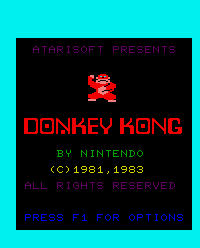
Wrapping Up
It should be noted that for a lot of the systems covered here MAME isn’t the absolute best emulator available, however, it’s certainly good enough for many use cases, as hopefully all these different versions of Donkey Kong running demonstrate. Knowing which machine to use, or how to configure the machine you want to use can be a challenge, and in some cases you’ll need to do a bit of research (I had to myself here for loading an MSX game from cassette) but don’t let that put you off, plenty really are just as easy to use as any arcade game.
What’s interesting with Donkey Kong is that while it was ported extensively outside of Japan there don’t seem to be that many cases where it was released on home systems in Japan, this contrasts greatly with the output of Namco where their most popular games were ported to a wide range of Japanese systems. Covering some of the Japanese systems is definitely an area I should consider for a follow-up article too because the obscure Japanese systems have some good ports and in many cases are an area in which the MESS code we’ve imported really excels.
I hope some of the things covered in this little write-up have been useful and again help show exactly what new abilities having the MESS code integrated has opened up to people. I think it’s fair to say that MAME is now the King of Kong, you can trace the game right from it’s arcade origins down to the best and worst of ports
*If* I do a Part 3 it will likely cover some even more advanced use cases for the emulator, such as using the PC emulation where you need to install the operating system first. I was going to do that using Raiden as an example (like Part 1), but have since discovered it suffers from an emulation glitch meaning I need to rethink my plan there.